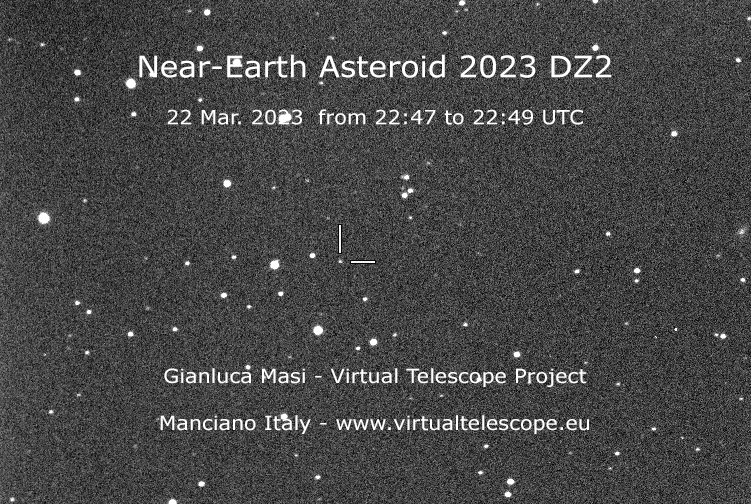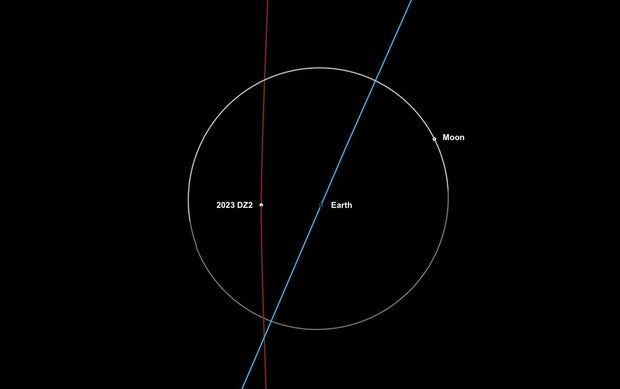BY EMILY MAE CZACHOR
MARCH 28, 2023 /
A large asteroid zipped past Earth last week, in a relatively rare event that astronomers described as one "very close encounter" with our planet.
The space rock, called 2023 DZ2 by NASA, reached its shortest distance from the atmosphere on Friday and Saturday. But it had been steadily approaching for some time before that. As the asteroid moved along its trajectory at speeds that, scientists estimated, exceeded 17,400 miles per hour — slower than a number of other cosmic objects that NASA regularly tracks and studies — astronomers at an observatory in Italy watched 2023 DZ2 and recorded its path through the sky.
Compiled using multiple exposures that each lasted 30-seconds, a glittering time-lapse video shows the asteroid traveling closer to Earth on March 22 and becoming brighter over the course of just two minutes.
The video was created by the Virtual Telescope Project, an initiative from the Italian astrophysicist and astronomer Gianluca Masi and the Bellatrix Astronomical Observatory that operates in Ceccano near the central coast of western Italy. The project uses robotic telescopes to observe space objects and cosmic events, which are then shared or live-streamed online.

This time-lapse sequence shows the path of the asteroid 2023 DZ2, which flew close to the Earth as it passed by last week.THE VIRTUAL TELESCOPE PROJECT
"At the imaging time, asteroid 2023 DZ2 was at about 1.8 millions of km from us and was safely approaching our planet, while getting brighter and brigther," the Virtual Telescope Project said when introducing the time-lapse sequence.
Astronomers at the observatory of La Palma in Spain's Canary Islands originally discovered the asteroid in February and announced the finding in March. Although for a time the asteroid appeared on the Sentry risk table, which keeps a running list of space objects that could potentially impact Earth, officials removed 2023 DZ2 from that list as it neared the planet.
The asteroid measured between 140 feet and 310 feet long, according to NASA, which noted later that 2023 DZ2's estimated average size was about 164 feet in diameter. That size is similar to the length of an Olympic-sized swimming pool or a commercial airplane.
"At the imaging time, asteroid 2023 DZ2 was at about 1.8 millions of km from us and was safely approaching our planet, while getting brighter and brigther," the Virtual Telescope Project said when introducing the time-lapse sequence.
Astronomers at the observatory of La Palma in Spain's Canary Islands originally discovered the asteroid in February and announced the finding in March. Although for a time the asteroid appeared on the Sentry risk table, which keeps a running list of space objects that could potentially impact Earth, officials removed 2023 DZ2 from that list as it neared the planet.
The asteroid measured between 140 feet and 310 feet long, according to NASA, which noted later that 2023 DZ2's estimated average size was about 164 feet in diameter. That size is similar to the length of an Olympic-sized swimming pool or a commercial airplane.
 NASA/CBS
NASA/CBSAlthough scientists determined ahead of time that the rock did not pose any threat to Earth, officials still deemed the flyby notable because it passed the planet at quite a close range — slightly less than half the average distance between the Earth and moon's respective orbits, which is about 108,000 miles from the ground.
"While close approaches are a regular occurrence, one by an asteroid of this size (140-310 ft) happens only about once per decade, providing a unique opportunity for science," the Twitter account NASA Asteroid Watch wrote last week. The agency had previously assigned a rarity score of three to 2023 DZ2 because of its size and anticipated trajectory.
"Astronomers with the International Asteroid Warning Network are using this close approach to learn as much as possible about 2023 DZ2 in a short time period - good practice for #PlanetaryDefense in the future if a potential asteroid threat were ever discovered," the account wrote in a separate tweet shared around the same time.
Ahead of the asteroid's closest approach to Earth on Friday and Saturday, when scientists suggested that people with small or standard telescopes may be able to spot it themselves, the official NASA Twitter account said current observations indicate "there is no known threat" of space objects impacting Earth for at least the next 100 years.
No comments:
Post a Comment